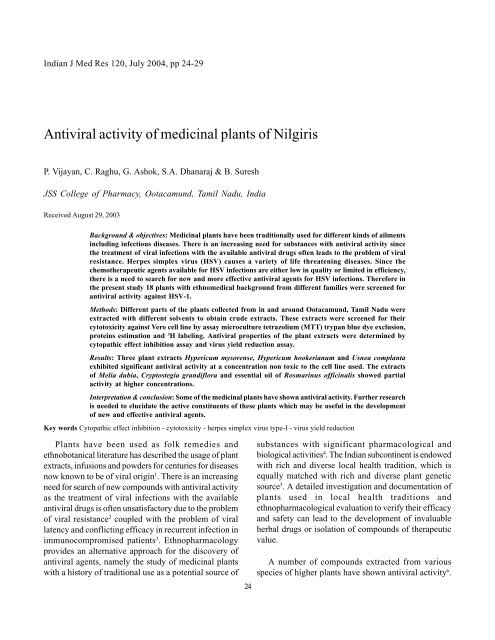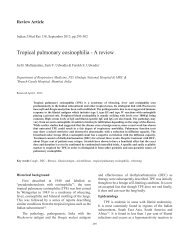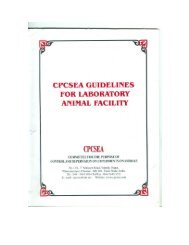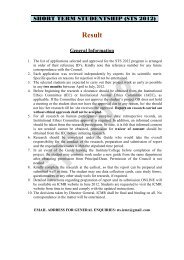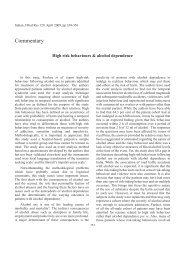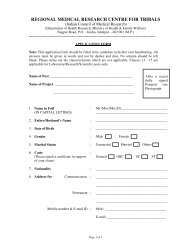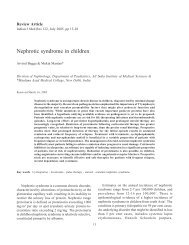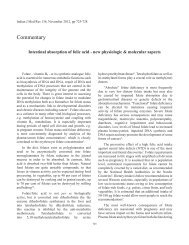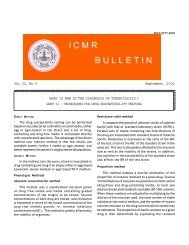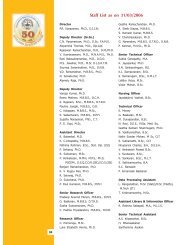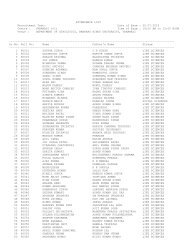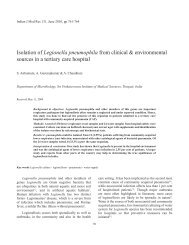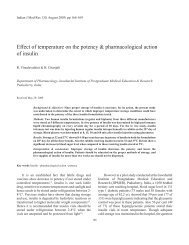Antiviral activity of medicinal plants of Nilgiris - Indian Council of ...
Antiviral activity of medicinal plants of Nilgiris - Indian Council of ...
Antiviral activity of medicinal plants of Nilgiris - Indian Council of ...
Create successful ePaper yourself
Turn your PDF publications into a flip-book with our unique Google optimized e-Paper software.
<strong>Indian</strong> J Med Res 120, July 2004, pp 24-29<br />
<strong>Antiviral</strong> <strong>activity</strong> <strong>of</strong> <strong>medicinal</strong> <strong>plants</strong> <strong>of</strong> <strong>Nilgiris</strong><br />
P. Vijayan, C. Raghu, G. Ashok, S.A. Dhanaraj & B. Suresh<br />
JSS College <strong>of</strong> Pharmacy, Ootacamund, Tamil Nadu, India<br />
Received August 29, 2003<br />
Background & objectives: Medicinal <strong>plants</strong> have been traditionally used for different kinds <strong>of</strong> ailments<br />
including infectious diseases. There is an increasing need for substances with antiviral <strong>activity</strong> since<br />
the treatment <strong>of</strong> viral infections with the available antiviral drugs <strong>of</strong>ten leads to the problem <strong>of</strong> viral<br />
resistance. Herpes simplex virus (HSV) causes a variety <strong>of</strong> life threatening diseases. Since the<br />
chemotherapeutic agents available for HSV infections are either low in quality or limited in efficiency,<br />
there is a need to search for new and more effective antiviral agents for HSV infections. Therefore in<br />
the present study 18 <strong>plants</strong> with ethnomedical background from different families were screened for<br />
antiviral <strong>activity</strong> against HSV-1.<br />
Methods: Different parts <strong>of</strong> the <strong>plants</strong> collected from in and around Ootacamund, Tamil Nadu were<br />
extracted with different solvents to obtain crude extracts. These extracts were screened for their<br />
cytotoxicity against Vero cell line by assay microculture tetrazolium (MTT) trypan blue dye exclusion,<br />
proteins estimation and 3H labeling. <strong>Antiviral</strong> properties <strong>of</strong> the plant extracts were determined by<br />
cytopathic effect inhibition assay and virus yield reduction assay.<br />
Results: Three plant extracts Hypericum mysorense, Hypericum hookerianum and Usnea complanta<br />
exhibited significant antiviral <strong>activity</strong> at a concentration non toxic to the cell line used. The extracts<br />
<strong>of</strong> Melia dubia, Cryptostegia grandiflora and essential oil <strong>of</strong> Rosmarinus <strong>of</strong>ficinalis showed partial<br />
<strong>activity</strong> at higher concentrations.<br />
Interpretation & conclusion: Some <strong>of</strong> the <strong>medicinal</strong> <strong>plants</strong> have shown antiviral <strong>activity</strong>. Further research<br />
is needed to elucidate the active constituents <strong>of</strong> these <strong>plants</strong> which may be useful in the development<br />
<strong>of</strong> new and effective antiviral agents.<br />
Key words Cytopathic effect inhibition - cytotoxicity - herpes simplex virus type-I - virus yield reduction<br />
Plants have been used as folk remedies and<br />
ethnobotanical literature has described the usage <strong>of</strong> plant<br />
extracts, infusions and powders for centuries for diseases<br />
now known to be <strong>of</strong> viral origin 1 . There is an increasing<br />
need for search <strong>of</strong> new compounds with antiviral <strong>activity</strong><br />
as the treatment <strong>of</strong> viral infections with the available<br />
antiviral drugs is <strong>of</strong>ten unsatisfactory due to the problem<br />
<strong>of</strong> viral resistance 2 coupled with the problem <strong>of</strong> viral<br />
latency and conflicting efficacy in recurrent infection in<br />
immunocompromised patients 3 . Ethnopharmacology<br />
provides an alternative approach for the discovery <strong>of</strong><br />
antiviral agents, namely the study <strong>of</strong> <strong>medicinal</strong> <strong>plants</strong><br />
with a history <strong>of</strong> traditional use as a potential source <strong>of</strong><br />
24<br />
substances with significant pharmacological and<br />
biological activities 4 . The <strong>Indian</strong> subcontinent is endowed<br />
with rich and diverse local health tradition, which is<br />
equally matched with rich and diverse plant genetic<br />
source 5 . A detailed investigation and documentation <strong>of</strong><br />
<strong>plants</strong> used in local health traditions and<br />
ethnopharmacological evaluation to verify their efficacy<br />
and safety can lead to the development <strong>of</strong> invaluable<br />
herbal drugs or isolation <strong>of</strong> compounds <strong>of</strong> therapeutic<br />
value.<br />
A number <strong>of</strong> compounds extracted from various<br />
species <strong>of</strong> higher <strong>plants</strong> have shown antiviral <strong>activity</strong> 6 .
VIJAYAN et al: ANTIVIRAL ACTIVITY OF MEDICINAL PLANTS<br />
Examples included tannins 7 , flavones 8 , alkaloids 9 , that<br />
displayed in vitro <strong>activity</strong> against numerous viruses. It<br />
has been suggested that selection <strong>of</strong> plant on the basis<br />
<strong>of</strong> ethnomedical considerations gives a higher hit rate<br />
than screening programmes <strong>of</strong> general synthetic<br />
products 10 . Bacopa monneri has been used in conditions<br />
like epilepsy, insanity, nervous disorders 11 , Hypercicum<br />
hookerianum in anxiety and inflammation 11 , Usnea<br />
complanta and Tagetes minuta for bacterial infections 11-13 ,<br />
Santolina chamaecyparissus as a stimulant, vermifuge<br />
and a stomachic 14 .<br />
A number <strong>of</strong> plant extracts reported in traditional<br />
medicine to have antiinfective properties were studied<br />
in our laboratory 15-19 and were also screened for antiviral<br />
<strong>activity</strong>.<br />
Herpes simplex viruses (HSV) are ubiquitous agents<br />
which cause a variety <strong>of</strong> diseases ranging in severity<br />
from mild to severe, and in certain cases, these may<br />
even become life threatenings, especially in<br />
immunocompromised patients. After primary infection,<br />
HSV persists in the host for the lifetime. HSV infection<br />
is thus considered lifelong infection. Nucleoside<br />
analogues such as aciclovir (ACV), penciclovir etc., are<br />
the only approved drugs for the treatment <strong>of</strong> HSV<br />
infections. However, the widespread use <strong>of</strong> nucleoside<br />
based drugs has led to the emergence <strong>of</strong> resistance in<br />
HSV especially among immunocompromised patients 3 .<br />
In a recent survey from Taiwan, the incidence <strong>of</strong> ACVresistant<br />
HSV strains was found to be around 5 per cent<br />
among immunocompromised patients and 14 per cent<br />
among bone marrow transplant recipients 20 . This<br />
indicates the need for search <strong>of</strong> newer antiviral agents<br />
to treat such infections.<br />
The present study was undertaken to test the extracts<br />
<strong>of</strong> 18 <strong>plants</strong> for their antiviral <strong>activity</strong> against herpes<br />
simplex virus type I (HSV-1, a DNA virus).<br />
Material & Methods<br />
Plant materials, reagents, cell line and virus: The plant<br />
materials were collected from in and around<br />
Ootacamund, Tamil Nadu, India and were authenticated<br />
by the Botanical Survey <strong>of</strong> India, Government Arts<br />
College, Ootacamund where sample specimens were<br />
deposited. Extracts <strong>of</strong> different <strong>plants</strong> were prepared<br />
25<br />
by using Soxhlet extraction unit (Borosil, Mumbai) as<br />
per the standard procedure 21 . The essential oils from<br />
different parts <strong>of</strong> <strong>plants</strong> were isolated by water distillation<br />
using Clavenges apparatus (Borosil, Mumbai) 22 .<br />
Eagle's minimum essential medium (EMEM), trypsin,<br />
penicillin, streptomycin and amphotericin B were<br />
purchased from Hi-media Labs, Mumbai, India. 3-(4, 5dimethylthiazol-2-yl)-2,5-diphenyl<br />
tetrazolium bromide<br />
(MTT) and trypan blue dye were purchased from Sigma,<br />
USA. New born calf serum (NBCS) was procured from<br />
PAA Labs, Austria.<br />
Vero cells (African green monkey kidney cell) were<br />
obtained from Pasteur Institute <strong>of</strong> India, Coonoor. Vero<br />
cells were grown in EMEM supplemented with Earle's<br />
salts and 10 per cent heat inactivated NBCS, 100 IU/ml<br />
penicillin, 100µg/ml streptomycin and 5µg/ml amphotericin<br />
B. The cells were maintained at 37ºC in a humidified<br />
atmosphere with 5 per cent CO 2 and were subcultured<br />
twice a week.<br />
HSV-1 was from the collection <strong>of</strong> the Christian<br />
Medical College and Hospital, Vellore. The virus was<br />
propagated in Vero cells and the infective titre <strong>of</strong> the<br />
stock solution was 10 -7 TCID 50 /ml (50% tissue culture<br />
infective dose).<br />
Cytotoxicity assay: Each extract was separately<br />
dissolved in 1 ml <strong>of</strong> distilled dimethyl sulphoxide (DMSO)<br />
and volume was made up to 10 ml with maintenance<br />
medium to obtain a stock solution <strong>of</strong> 1 mg/ml<br />
concentration, sterilized by filtration and further dilutions<br />
were made from the stock. The cytotoxicity assays were<br />
carried out using 0.1ml <strong>of</strong> cell suspension, containing<br />
10,000 cells seeded in each well <strong>of</strong> a 96-well microtitre<br />
plate (Tarsons India Pvt. Ltd., Kolkata). Fresh medium<br />
containing different concentrations <strong>of</strong> the test sample<br />
was added after 24 h <strong>of</strong> seeding. Control cells were<br />
incubated without test sample and with DMSO. The little<br />
percentage <strong>of</strong> DMSO present in the wells (maximal 0.2%)<br />
was found not to affect the experiment. The microtitre<br />
plates were incubated at 37ºC in a humidified incubator<br />
with 5 per cent CO 2 for a period <strong>of</strong> 72 h. Sixteen wells<br />
were used for each concentration <strong>of</strong> the test sample.<br />
The morphology <strong>of</strong> the cells was inspected daily and<br />
observed for microscopically detectable alterations, i.e.,<br />
loss <strong>of</strong> monolayer, granulation and vacuolization in the
26<br />
cytoplasm. The cytopathogenic effect (CPE) was<br />
scored. The 50 per cent cytotoxic concentration (CTC 50 ),<br />
was determined by the standard MTT assay 23,24 , trypan<br />
blue dye exclusion method 25 , cell metabolic function by<br />
protein estimation 26 , and total cellular DNA content by<br />
3 H thymidine labeling 27 .<br />
<strong>Antiviral</strong> assay: Different nontoxic concentrations <strong>of</strong><br />
test drugs, i.e., lower than CTC 50 were checked for<br />
antiviral property by cytopathic effect (CPE) inhibition<br />
INDIAN J MED RES, JULY 2004<br />
Table I. Ethnobotanical data <strong>of</strong> selected <strong>medicinal</strong> <strong>plants</strong><br />
assay 28 and virus yield reduction assay 29 against different<br />
virus challenge doses <strong>of</strong> 2, 10 and 100 TCID 50 . In CPE<br />
inhibition assay, cells were seeded in a 96-well microtitre<br />
plate with 10,000 cells per well, incubated at 37ºC in a<br />
humidified incubator with 5 per cent CO 2 for a period <strong>of</strong><br />
48 h. The plates were washed with fresh MEM and<br />
challenged with different virus challenge doses and<br />
incubated at 37ºC for 90 min for adsorption <strong>of</strong> the virus.<br />
The cultures were treated with different dilutions <strong>of</strong> plant<br />
extracts in fresh maintenance medium and incubated at<br />
Plant name Family Part used Extracts Local name Local uses<br />
prepared<br />
Bacopa monnieri Linn. Scrophulariaceae Whole plant Aqueous Nir brahmi In epilepsy, insanity,<br />
nervous disorders 11<br />
Solanum trilobatum Linn. Solanaceae Leaves Aqueous Tuduvalai In constipation, cough, acute &<br />
chronic bronchitis 11,14<br />
Hibiscus vitifolius Linn. Malvaceae Root bark Aqueous & Karupatti In jaundice, inflammation,<br />
alcohol diabetes, urease <strong>activity</strong> 30<br />
Allium cepa Linn. Lilliaceae Bulb Aqueous Vengayam In malaria, asthma, fever,<br />
chronic bronchitis 11<br />
Derris brevipes (Benth) Baker Papilonaceae Root Aqueous As abortifacient 31<br />
Hypericum mysorense Weight&Arn. Hypericaceae Aerial parts Methanol Hypericum In anxiety, inflammation 11<br />
Hypericum hookerianum Weight&Arn. Hypericaceae Aerial parts Methanol Hypericum In anxiety, inflammation 11<br />
Berberis tinctoria Lesch Berberidaceae Root Methanol Oosikala In stomachache, ulcer,<br />
haemor 32<br />
Mahonia leschenaultia Takeda Berberidaceae Root Methanol Mulkadambu In postnatal conditions,<br />
jaundice, fever 14<br />
Usnea complanta Stirt Usneaceae Whole plant Acetone & Marappasi In bacterial infections13 chlor<strong>of</strong>orm<br />
Tagetes minuta Linn. Asteraceae Whole plant Essential oil Stinking rogar As diuretic, anti inflammatory,<br />
stomachic12 Leucas lavandulaefolia JE. Sm. Labiatae Aerial parts Methanol Mosappullu In sedativeness, nervous<br />
disorders, as vermifuge 11,14<br />
Melia dubia Cav. Meliaceae Fruits Alcohol & Malaivanbu As anthlementic,<br />
ethyl acetate skin disorders 11,14<br />
Azadirachta indica A.juss. Meliaceae Leaves Essential oil Vembu, Vepa As antibacterial,<br />
antihelminthitic 11<br />
Santolina chamaecyparissus Linn. Asteraceae Whole plant Essential oil Lavender As plant stimulant, vermifuge,<br />
cotton stomachic 14<br />
Cryptostegia grandiflora R.Br Asclepidaceae Whole plant Methanol Palai Stimulant, in inflammations,<br />
antibacterial 18,32<br />
Daucus carota Linn. Umbelliferae Seeds Essential oil Karatu As diuretic, stimulant 11<br />
Rosmarinus <strong>of</strong>ficinalis Linn. Labiatae Aerial parts Essential oil Rusmari Carminative, diuretic,<br />
stimulant, for hair wash 11,14
VIJAYAN et al: ANTIVIRAL ACTIVITY OF MEDICINAL PLANTS<br />
37ºC for five days. Every 24 h the observation was made<br />
and cytopathic effects were recorded. Anti-HSV-1<br />
<strong>activity</strong> was determined by the inhibition <strong>of</strong> cytopathic<br />
effect compared with control, i.e., the protection <strong>of</strong>fered<br />
by the test samples to the cells was scored. In virus<br />
yield assay, reduction in the yield <strong>of</strong> virus when cells<br />
were treated with the plant extracts was determined.<br />
Results<br />
Different parts <strong>of</strong> 18 <strong>medicinal</strong> <strong>plants</strong> belonging to 14<br />
different families (Table I) used in the traditional system<br />
<strong>of</strong> medicine collected from <strong>Nilgiris</strong> were tested for their<br />
antiviral <strong>activity</strong>. Seven plant extracts from six different<br />
families were found to have antiviral <strong>activity</strong> against<br />
HSV-1, at a concentration non toxic to the cell line (Vero)<br />
used (Table II). Most <strong>of</strong> these extracts have partial<br />
<strong>activity</strong> at the low concentration used. The methanol<br />
extracts <strong>of</strong> the aerial parts <strong>of</strong> Hypericum mysorense<br />
and Hypericum hookerianum, exhibited detectable<br />
antiviral effect towards HSV-1 with an inhibitory<br />
concentration for 50 per cent (IC 50 ) <strong>of</strong> 100 and 50µg/ml<br />
respectively. The acetone extract <strong>of</strong> Usnea complanta<br />
also showed antiviral <strong>activity</strong> at an IC 50 value <strong>of</strong> 100 µg/<br />
ml. The extracts <strong>of</strong> Melia dubia, Cryptostegia<br />
grandiflora and essential oil <strong>of</strong> Rosmarinus <strong>of</strong>ficinalis<br />
Table II. Cytotoxicity and antiviral <strong>activity</strong> <strong>of</strong> selected plant extracts<br />
27<br />
exhibited a partial <strong>activity</strong> at higher concentrations. Other<br />
plant extracts failed to show significant antiviral property.<br />
From the 21 extracts tested, four <strong>plants</strong> Usnea<br />
complanta, Berberis tinctoria, Mahonia leschenaultii<br />
and Togetes minuta showed significant cytotoxicity<br />
against Vero cells, the IC 50 value ranging between 37-<br />
49 µg/ml.<br />
The results obtained by both CPE inhibition assay<br />
and virus yield assay were comparable. The extracts <strong>of</strong><br />
Hypericum mysorense and Hypericum hookerianum<br />
exhibited virus inhibitory <strong>activity</strong> by both the assays. But<br />
the remaining plant extracts failed to reduce the virus<br />
yield in comparison to the yield obtained in the virus<br />
controls and the virus yield reduction was found to be<br />
less than 0.5 log.<br />
Discussion<br />
The results from this preliminary investigation provide<br />
evidence <strong>of</strong> the importance <strong>of</strong> ethnopharmacology as a<br />
guide to the screening <strong>of</strong> biologically active plant<br />
materials 33 . We used 100 per cent inactivation to define<br />
an extract with antiviral <strong>activity</strong>, but many extracts had<br />
partial antiviral <strong>activity</strong>.<br />
Name <strong>of</strong> the plant Extract Cytotoxicity Concentration CPE inhibition assay<br />
µg/ml tested (µg/ml)<br />
IC50 2 TCID50 10 TCID50 100 TCID50 Hypericum mysorense Methanol 123 100 ++++ ++++ ++++<br />
50 ++++ +++ ++<br />
Hypericum hookerianum Methanol 122 100 ++++ ++++ ++++<br />
50 +++ ++ +<br />
Usnea complanta Acetone 123 100 ++++ ++++ ++<br />
50 ++++ +++ +<br />
Cryptostegia grandiflora Methanol 182 150 ++ ++ +<br />
100 ++ + +<br />
Rosmarinus <strong>of</strong>ficinalis essential oil 349 300 ++ + +<br />
200 + + +<br />
0, no potection; +, 25% protection; ++, 50 protection; +++, 75% protection; ++++, 100% protection<br />
CPE, cytopathic effect<br />
IC , inhibitory concentration for 50 per cent <strong>of</strong> viruses<br />
50
28<br />
Of the 18 plant extracts tested, three (H. mysorense,<br />
H. hookerianum and U. complanta) were found to<br />
exhibit potent antiviral <strong>activity</strong>. H. mysorense and H.<br />
hookerianum are used in the treatment for anxiety and<br />
inflammation traditionally 11 . Hypericum perforatum<br />
from the same species is reported for its antiviral <strong>activity</strong><br />
against human immunodeficiency virus (HIV) 34 and<br />
hepatitis C virus 35 . Three plant species Hypericums<br />
connatum, Hypericum caprifoliatum and Hypericum<br />
polyanthemum (Guttiferae), growing in Southern Brazil<br />
were chemically investigated and tested for their antiviral<br />
<strong>activity</strong> against feline immunodeficiency virus (FIV) 36 .<br />
Our results showed that H. mysorense and<br />
H. hookerianum suppressed HSV-1 infection. These<br />
extracts may have compounds that are true antiviral,<br />
but are present at quantities insufficient to inactivate all<br />
infectious virus particles. It is possible that the elucidation<br />
<strong>of</strong> active constituents in these <strong>plants</strong> may provide useful<br />
lead to the development <strong>of</strong> new and effective antiviral<br />
agents.<br />
Acknowledgment<br />
The authors acknowledge the Department <strong>of</strong> Biotechnology,<br />
Government <strong>of</strong> India, New Delhi for financial support.<br />
References<br />
1. Vanden Berghe DA, Vlietinck AJ, Vanho<strong>of</strong> L. Plant products as<br />
potential antiviral agents. Bull Inst Pasteur 1986; 84 : 101-47.<br />
2. De Clercq E. <strong>Antiviral</strong> agents: characteristic <strong>activity</strong> spectrum<br />
depending on the molecular target with which they interact.<br />
Adv Virus Res 1993; 42 : 1-55.<br />
3. Field AK, Biron KK. The end <strong>of</strong> innocerice revisited: resistance<br />
<strong>of</strong> herpesvirus to antiviral drugs. Clin Microbiol Rev 1994;<br />
7 : 1-13.<br />
4. Vlietinck AJ, Vanden Berghe DA. Can ethnopharmacology<br />
contribute to the development <strong>of</strong> antiviral drugs?<br />
J Ethnopharmacol 1991; 32 : 141-53.<br />
5. Pushpangadan P. Role <strong>of</strong> traditional medicine in primary health<br />
care. In: Iyengar PK, Damodaran VK, Pushpangandan P, editors.<br />
Science for health. Trivandrum: State Committee on Science,<br />
Technology and Environment, Government <strong>of</strong> Kerala; 1995.<br />
6. Hudson JB. <strong>Antiviral</strong> compounds from <strong>plants</strong>. Boca Raton,<br />
Florida: CRC Press; 1990 p. 200.<br />
7. Fukuchi K, Sakagarmi H, Okuda T, Hatano T, Tanuma S, Kitajima<br />
K, et al. Inhibition <strong>of</strong> herpes simplex virus infection by tannis and<br />
related compounds. <strong>Antiviral</strong> Res 1989; 11 : 285-97.<br />
8. De Rodriguez DJ, Chula J, Simons C, Armoros M, Veriohe<br />
AM, Girre L. Search for in vitro antiviral <strong>activity</strong> <strong>of</strong> a new<br />
INDIAN J MED RES, JULY 2004<br />
is<strong>of</strong>lavone glycoside from Vlex europeus. Planta Med 1990;<br />
50 : 59-62.<br />
9. Spedding G, Ratty A, Middleton E Jr. Inhibition <strong>of</strong> reverse<br />
transcriptases by flavonoids. <strong>Antiviral</strong> Res 1989; 12 : 99-110.<br />
10. Vanden Berghe DA, Vlietinek AJ. Screening methods for<br />
antibacterial and antiviral agents from higher <strong>plants</strong>. In:<br />
Hostettmann K, editor. Methods in biochemistry. vol 6. London:<br />
Academic Press; 1991 p. 47.<br />
11. The wealth <strong>of</strong> India, New Delhi: <strong>Council</strong> <strong>of</strong> Scientific and<br />
Industrial Research; 1995.<br />
12. Ambasta SP, editor, The useful <strong>plants</strong> <strong>of</strong> India. New Delhi:<br />
<strong>Council</strong> <strong>of</strong> Scientific and Industrial Research; 1986 p. 617.<br />
13. Hobbs C. Usnea: The herbal antibiotic. Capitola (CA): Botanic<br />
Press; 1986 p. 913.<br />
14. Yoganarasimhan SN. Medicinal <strong>plants</strong> <strong>of</strong> India, Tamil Nadu.<br />
vol 2, Bangalore: Cyber Media; 2000.<br />
15. Vijayan P, Vinod Kumar S, Dhanaraj SA, Badami S, Suresh B. In<br />
vitro cytotoxicity and antitumor properties <strong>of</strong> the total alkaloid<br />
fraction <strong>of</strong> unripe fruits <strong>of</strong> Solanum pseudocapsicum. Pharm<br />
Biol 2002; 40 : 456-60.<br />
16. Vijayan P, Vinod Kumar S, Dhanaraj SA, Mukherjee PK,<br />
Suresh B. In vitro cytotoxicity and antitumour properties<br />
<strong>of</strong> Hypericum mysorense and Hypericum patulum. Phytother<br />
Res 2003; 17 : 952-6.<br />
17. Vijayan P, Prashanth HC, Vijayaraj P, Dhanaraj SA, Badami S,<br />
Suresh B. Hepatoprotective effect <strong>of</strong> the total alkaloid fraction<br />
<strong>of</strong> Solanum pseudocapsicum leaves. Pharm Biol 2003; 41 :<br />
443-8.<br />
18. Mukherjee PK, Gunasekharan R, Subburaju T, Dhanbal SP,<br />
Duraiswamy P, Vijayan P, et al. Studies on the antibacterial<br />
potential <strong>of</strong> Cryptostegia grandiflora R.Br. (Asclepiadaceae)<br />
extract. Phytother Res 1999; 13 : 70-2.<br />
19. Badami S, Vijayan P, Mathew N, Chandrashekhar R, Ashok G,<br />
Dhanaraj SA, et al. In vitro cytotoxic properties <strong>of</strong> Grewia<br />
tiliafolia bark and Lupeol. <strong>Indian</strong> J Pharmacol 2003; 35 : 250-1.<br />
20. Chiang LC, Cheng HY, Liu MC, Chiang W, Lin CC. In vitro antiherpes<br />
simplex viruses and anti-adenoviruses <strong>activity</strong> <strong>of</strong> twelve<br />
traditionally used <strong>medicinal</strong> <strong>plants</strong> in Taiwan. Biol Pharm Bull<br />
2003; 26 : 1600-4.<br />
21. Carter SJ, editor. Cooper and Gunn's tutorial pharmacy.<br />
New Delhi: CBS Publishers & Distributors; 1986 p. 257-9.<br />
22. Guenther E. The essential oils, vol. 1. New York: D Van Nostrand<br />
Company Inc; 1955 p. 317.<br />
23. Francis D, Rita L. Rapid colorimetric assay for cell growth and<br />
survival: modifications to the tetrazolium dye procedure giving<br />
improved sensitivity and reliability. J Immunol Methods 1986;<br />
89 : 271-7.<br />
24. Ke H, Hisayoshi K, Aijun D, Yonngkui J, Shigeo I, Xinsheng Y.<br />
Antineoplastic agents-III: steroidal glycosides from Solanum<br />
nigrum. Planta Med 1999; 65 : 35-8.
VIJAYAN et al: ANTIVIRAL ACTIVITY OF MEDICINAL PLANTS<br />
25. Moldeus P, Hogberg J, Orrhenius S, Fleischer S, Packer L.<br />
Methods in enzymology, vol.52, New York: Academic Press;<br />
1978 p. 60-71.<br />
26. Lowry ON, Roseborough NJ, Farr AL, Randall RJ. Protein<br />
measurement with Folin phenol reagent. J Biol Chem 1951;<br />
193 : 265-75.<br />
27. De Clereq E, Holy A, Rosenberg I. Efficacy <strong>of</strong><br />
phosphonyl methoxyalkyl derivatives <strong>of</strong> adenine in experimental<br />
herpes simplex virus and vaccinia virus infections in vivo.<br />
Antimicrob Agents Chemother 1989; 33 : 185-91.<br />
28. Hu JM, Hsiung GD. Evaluation <strong>of</strong> new antiviral agents I:<br />
In vitro prospectives. <strong>Antiviral</strong> Res 1989; 11 : 217-32.<br />
29. Cinatl J, Vogel U, Cinatl J, Kabickova H, Kornhuber B, Doerr<br />
HW. <strong>Antiviral</strong> effects <strong>of</strong> 6-diazo-5-oxo-L-norleucin on replication<br />
<strong>of</strong> Herpes Simplex Virus type-1. <strong>Antiviral</strong> Res 1997; 33 : 165-<br />
75.<br />
30. Singh U, Wadhwani AM, Johri BM. Dictionary <strong>of</strong> economic<br />
<strong>plants</strong> <strong>of</strong> India. New Delhi: <strong>Indian</strong> <strong>Council</strong> <strong>of</strong> Agricultural<br />
Research; 1983 (reprinted) p. 100.<br />
Reprint requests: Dr P. Vijayan, Department <strong>of</strong> Pharmaceutical Biotechnology, JSS College <strong>of</strong> Pharmacy<br />
Ootacamund 643001, India<br />
e-mail: vijayanp4@rediffmail.com<br />
29<br />
31. Badami S, Aneesh R, Sankar S, Sahishkumar MN, Suresh B,<br />
Rajan S. Antifertility <strong>activity</strong> <strong>of</strong> Derris brevipes variety coriacea.<br />
J Ethnopharmacol 2003; 84 : 99-104.<br />
32. Kiritikar KR, Basu BD. <strong>Indian</strong> <strong>medicinal</strong> <strong>plants</strong> vol 1-4,<br />
Dehradun: International Book Distributors; 1987.<br />
33. Farnsworth NR, Kaas CJ. An approach utilizing information<br />
from traditional medicine to identify tumor-inhibiting <strong>plants</strong>.<br />
J Ethnopharmacol 1981; 3 : 85-99.<br />
34. Lavie G, Mazur Y, Lavie D, Meruelo D. The chemical and<br />
biological properties <strong>of</strong> hypericin- a compound with a broad<br />
spectrum <strong>of</strong> biological activities. Med Res Rev 1995; 15 : 111-9.<br />
35. Jacobson JM, Feinman L, Liebes L, Ostrow N, Koslowski V,<br />
Tobia A, et al. Pharmacokinetics, safety, and antiviral effects <strong>of</strong><br />
hypericin, a derivative <strong>of</strong> St. John's wort plant, in patients with<br />
chronic hepatitis C virus infection. Antimicrob Agents Chemother<br />
2001; 45 : 517-24.<br />
36. Schmitt AC, Ravazzolo AP, von Poser GL. Investigation <strong>of</strong><br />
some Hypericum species native to Southern <strong>of</strong> Brazil for antiviral<br />
<strong>activity</strong>. J Ethnopharmacol 2001; 77 : 239-45.


